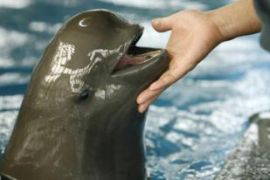Climate change worsens biodiversity
Environmental change is affecting the ability of species to survive.

“The consequences of habitat change, changes in temperature, food, will, and is already beginning to, fundamentally affect the ability of species to survive,” said Steiner.
“If people in one part of the world don’t have a species there, the cause for its disappearance may well be at the other end of the world,” he said.
The species at risk include the North Atlantic right whale, whose main food supply, plankton, is declining because of a shift in ocean currents, according to the document, compiled by Unep’s Convention on Migratory Species (CMS) with help from Britain’s Department of the Environment.
The range of white-beaked dolphins is reducing because it follows its prey and cannot adapt to warmer waters.
Global warming may contribute to outbreaks of disease among animals, Unep warned.
“Mass die-offs of marine mammals have increased, and where the cause has been viral, environmental factors have contributed to the outbreaks or reduced the ability of the animals to fend off the illnesses,” said the report.
Tumorous growths in green turtles have become more common since the 1980s, a phenomenon linked to warmer water, which allows diseases and parasites to thrive, it said.
Sex ratios
High temperatures on nesting beaches can also affect the sex ratio among certain turtle species. Higher temperatures, in the range of 25-32 C (77-89 F), lead to a greater number of female hatchlings.
An imbalance of one male to two females or one to three will have no ill effect, but if the proportions move towards one to four, populations could decline.
“Some nesting beaches are seeing temperatures rise above 34 C (93 F), which is often lethal,” said the report, Migratory Species and Climate Change: Impacts of a Changing Environment on Wild Animals.
Lower water tables and more frequent droughts will reduce habitat for a many birds.
Rising sea levels, coastal erosion and more powerful waves will threaten the lesser-white fronted goose, a migratory species that makes several stopovers on its long migration.
“Since migratory species rely on a number of different habitats, once you affect one you can effect the whole migration of the animal,” said Paola Deda, coordinator of CMS’s wildlife monitoring initiative.
Abandoning migration
Deda’s project works to document major changes in the length, timing and location of migration routes and had found that, in extreme cases, species had abandoned migration altogether.
Increasingly, species that had never been spotted in areas except as exotic vagrants are taking up residence or migrating there.
Southern fish such as the red mullet, anchovy and sardine, which are now being found in the North Sea, and the rosy-breasted trumpeter, one of many birds once normally confined to arid North Africa and the Middle East but now increasingly seen in southern Spain.
Warmer waters also favour the common dolphin, whose range is increasing.
“Part of the challenge of understanding biodiversity is that its complexity in terms of interdependence is so little understood by us as humans,” said Steiner.
“We may often think ‘What does it matter if we lose a species?’ And only years later do we realise that the displacement of one species may have a series of effects on other species,” he said.